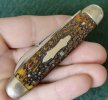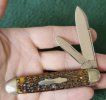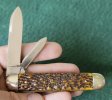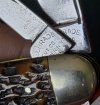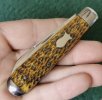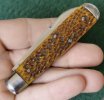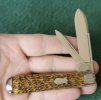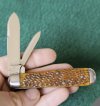lambertiana
Gold Member
- Joined
- Jul 7, 2000
- Messages
- 9,735
Interesting motif. What kind of business was Casa Viamonte?
The BladeForums.com 2024 Traditional Knife is available! Price is $250 ea (shipped within CONUS).
Order here: https://www.bladeforums.com/help/2024-traditional/
Some nice knives posted above
... especially like those HJs Charlie and Duncan
Here are a few different old knives for this thread and I say with a grin not associated with cutting apples but I guess someone could if they wanted.. Two old dirks or maybe more appropriately daggers with different origins but both with that classic swedge associated with these single edge cutting blades running along the spine from tang to tip (though the Frosolone knife is technically called a sfilato from its Italian roots)…. Just as an aside I think the terminology is somewhat cloudy and confusing for dirk vs dagger and it no doubt depends on who you read - I believe technically these are dirks (despite some who define daggers as double cutting edge knives) - small daggers in Scotland are called dirks and are single cutting edges – yet large pointed symmetrical blade that are almost short swords are also called dirks or daggers again depending who you read.... guess I’ll go with dirk for the first knife which can be defined as a small dagger
….
This first dirk found on a local antique barn hunt appears that it was most likely made in Sheffield or one of the other areas for cutlery in the UK though I can’t rule out early American either (showing to a few other collectors I heard Sheffield as most likely and recently I saw an old Sheffield made jack that was a barehead and squared off as seen in this knife so essentially the same design – so at least the style was possible from Sheffield) – absolutely no signs of a tang stamp or makers mark so tough to identify in terms of a maker… anyway all iron construction including liners, bolster and lockback… still a very functional knife with snap and solid, and the lock-back works perfectly. This knife no doubt was well carried for years – the stag is very pocket worn and no doubt thin from years of carry which to me is pretty cool – it does look like there was 2 pins added to the mark side handle and done very cleanly which probably reinforced the stag to the liner but have no clue when along the way this was done as a means to preserve the handle cover (from a personal standpoint it is not something I would do but this knife may have lost the mark side stag if not for the extra pins so in a way I’m good with it– no doubt rest of pins are all original… my guess on age of knife is +/- mid 1800s… no doubt this was the type of knife carried as a weapon but probably could have seen some other cutting purposes as well… Closed length is 4 & 1/2”…



The second is not one I ordinarily collect as it is outside my geographic collecting zonebut I couldn’t resist it a few years ago when discovered on another local hunt at an “antique” barn – I categorize these knives as my “special opportunities” part of my accumulation
… The knife is stamped and made in Frosolone (Italy) and Frosolone was no doubt an important center of knife making in the world in the latter 1800s - early 1900s and still today has some active cutleries though not as numerous as the past.. I believe in 1900 there were more than eighty cutlery shops in addition to a big steel industry… Like the first one this also has all iron construction and despite the crack and few marks on horn handles it is a very solid knife (that crack in the horn on mark side is solid and not going anywhere and most likely occurred with age and drying)… These knives were termed sfilatos in Italy and many cutlers made this design. Interesting that the stamp of “Frosolone” is upside down in terms of what is normally seen on tang stamps in addition to no maker mark… as I read about Frosolone in the late 1800s it was in a sense very much like Sheffield with many makers and shops, lots of apprentices etc, and thus very hard if not impossible now to nail down the maker… knives from Frosolone were known for blade stamps or etches rather than found conventionally on the tang but I suppose both were done pending the cutler – additionally not all cutlers used their name as some only stamped Frosolone… Frosolone still has some knife makers today and I sent photos of this knife to a current Frosolone cutler who appears to be well versed in Frosolone history – he confirmed the knife was made in the latter quarter of the1800s and no later than very early 1900s… he noted it was a classic design in all ways for that time period based on materials etc. Some other background reading noted that when lockback knives became illegal in Italy in 1871 this folding sfilato was developed and continued as a style still associated with Frosolone today… Closed length is 4 & 7/8” …




Cheers!
Lee
Where and when did this post come from, years ago? What page was it on? I know Lee.
Click on the user name at the top of the quoted post and it takes you to the original post. So click on "LongBlade" and it shows that the original poast was in this thread in 2017.Yeah, I looked for it also!!
Thanks for that tip!!! I've run into that dilemma many times!!Click on the user name at the top of the quoted post and it takes you to the original post. So click on "LongBlade" and it shows that the original poast was in this thread in 2017.
Nice find!! Lots of blade left, and great sawcut handles!!!!!I picked up this sweet little Furness Barlow on Ebay. I'm not sure how old it is.
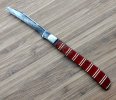
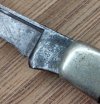
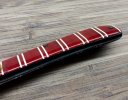
Thank you!Whatever you do my friend, keep that gassing Celluloid right away from any other knives you have, it will eat them alive- like it is doing to the liners of that Knife now!
Your knife is really going to town, its under the Bolster- you can see the tang starting to go now too.
I used to own a Harris Bros Fixed Blade, I really regretted selling that one! I think it had on the cover a birthday engraving to a young man in 1926.
Harris Bros were not a manufacturer, so is your Knife a Case, Remington etc etc I don't know?
Harris Bros in Levine 4: 1915
Harris Bros in Goins: 1915 - 1926.
Once a beauty, that cool celluloid is deconstructing itself and the knife pretty badly!I am well aware of how thrashed this old bugger is, but I was hoping someone can point me in the direction to get started reading about these knives. There doesn't seem to be much around on Google.
Harris Bros & Co, Chicago Ill on the tang stamp. Really neat looking celluloid. All pinned construction. Nickel bolsters. Long pull and swedge on a clip blade. It was, in its day, a decently made slim trapper.
Someone obviously loved it. I found it in a very old desk where I believe it's been used to open letters for the last many decades of its life.
Still sharp as a razor too, despite missing so much blade. Smooth and snappy as well lol! Shame that it's in the condition it's in, but neat none the less
As far as I can tell from searching, it's probably pushing a hundred years old give or take.
If anyone has any thoughts on the company or could possibly go into detail about it a bit I'd really appreciate it!
Thanks for any consideration
View attachment 2789844View attachment 2789845View attachment 2789846
Wow I've seen celluloid watch crystals deteriorate and I've seen it eat watch hands and destroy metal dials and rust steel watch cases.... But I've never seen it actually rot itself away like that on an old knife. Holy cow.Once a beauty, that cool celluloid is deconstructing itself and the knife pretty badly!
The off-gassing is acidic!!
You now have a science project, which needs to be isolated from other nice objects, as you watch it deteriorate further!!
Yup!! Science project for sure!! Keep it in a small sealed container, and check it every few months!! Progress (if you can call it that) pics would make an interesting thread!!I guess I could rip it off and put something new on it. If the blade wasn't so far gone.... Lol. Seems like it's doomed anyhow.

